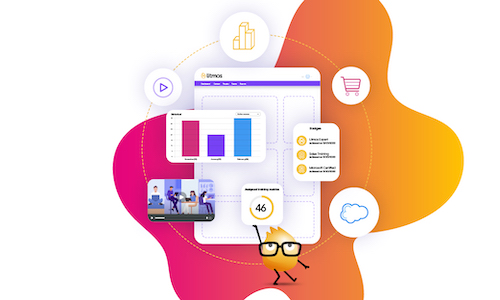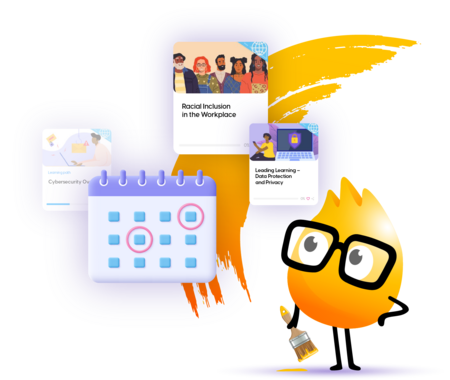Choosing the Right Technology for Sales Training
Salespeople are active. They’re active in their jobs, and they are active learners. However, sales training itself tends to be very theoretical. What sales teams often need is a real-life approach to sales, and a chance to apply the skills they’re learning.
Using technologies, such as sales LMS, sales enablement, and sales analytics tools can help your team learn, practice, and apply sales training. These tools can also help managers track the training progress of their salespeople. In this blog post, I’ll explore the benefits of technological solutions for sales, top technological solutions that sales teams use on the ground, and how to choose the best technological solutions for your sales team.
Why is technology important for sales teams?
When you hire a new sales rep, they’re not productive right away; depending on your company’s product or service, it can take between three to nine months for your rep to get up to speed and ready to sell.
This is just one training challenge faced by sales teams. Sales managers are also facing struggling reps, increasing revenue goals, and teams that are still adapting to virtual selling.
Technology can help sales teams learn and grow faster by deploying tailored sales training to the reps who need it and tracking their learning progress. Rather than relying on in-person training events, technology makes training an ongoing process.
Sales is uniquely positioned to take advantage of learning technology, simply because sales departments collect so many metrics; and tracking the right metrics is part of a successful L&D strategy.
If you work in sales, you’re working in one of the most closely-monitored and quantifiable areas of a business. Everything is measured, from revenue goals to data around each customer. That information is a goldmine for learning technology, which tracks and measures remediation.
Thanks to the metrics around sales, it’s pretty easy to pinpoint where your processes are failing, where leads are dropping out of your sales pipeline, and where individual team members need support. I recommend that that sales managers find technological solutions that help them interrogate this wealth of data to pinpoint what’s going wrong, and who needs to see the training. They can then can use their existing data as a baseline to measure against as they implement their training programs.
Types of sales training technology
There is a wide variety of sales training technology available, many of which integrate with one another. Knowing what problems you’re planning to address through technology – whether it’s training, enablement, or performance – can be a helpful way to identify which solution is best for your sales team.
Learning management systems
A learning management system (LMS) is an online platform for delivering, tracking, and managing learning and training programs. It is a centralized system that enables organizations to create, deliver, and track learning content, as well as manage learner progress, assessments, and certifications.
Sales enablement platforms
Sales enablement is the process of providing your sales team with the information, content and tools that help salespeople sell more effectively. A sales enablement platform allows you to create, manage, and track those materials.
Sales analytics tools
Sales analytics tools track metrics around sales. These tools can help managers track performance and identify knowledge or skills gaps that should be addressed with L&D content.
How to choose the LMS for sales training
Once you know what problems you’re planning to solve with technology, it’s time to look for a solution that fits your organization’s budget and existing tech stack.
There are three key characteristics to consider when you’re shopping around for a sales training solution:
1. Usability
First and foremost, look for a user-friendly interface. Your sales LMS should be easy to use, accessible, and easy to implement. Using an LMS should feel as effortless as possible, which means no complex navigation and not too many clicks to get to the training content you need.
Look for a sales training solution that seamlessly integrates with your existing CRM. This will help you deliver content to your team while they are in the flow of work. User-friendliness goes beyond the interface itself; the off-the-shelf training content that your learning solution offers should also be intuitively designed and easy to use.
2. Engagement
Sales is an active process, so sales training needs to be as interactive and dynamic as possible. This can look many ways:
- Personalized learning: Your team members have different learning needs, and it’s important to provide them with targeted learning. Look for a platform that lets you to customize learning paths, and that allows you to adapt and redeploy content for different needs.
- Gamification: Gamification is the introduction of game mechanics into non-game situations, like work or training. Although gamification can take several forms in training it’s most often seen as a point system. It’s a natural fit for salespeople, who can be competitive by nature. Incorporating gamification into sales training is a way to keep your team engaged with your training content while sparking some healthy competition between team members.
- Live training: When we think of training technology, the online quiz often comes to mind. However, there’s much more to learning technology than quizzes. Look for the ability to offer live training, such as Instructor Led Training (ILT) or Virtual Instructor-led Training (VILT), so that learners can connect with their instructors and one another.
- Relevant content: Avoid outdated content or content that doesn’t resonate with your team. An info dump won’t inspire or inform a salesperson. Make sure that your sales training materials reflect your organization’s brand and ethos. If a salesperson in your organization would never speak to a customer in a certain way, why would you speak to the salesperson that way within your learning content? The more active and engaging your content is, the more your team will respond to it.
3. Mobile accessibility
Mobile learning is a must-have for sales teams in the field. For example, it’s important to be able to get content in front of salespeople who may be travelling to meetings. It’s also important that learning be available online and offline.
Another, increasingly common use case for mobile accessibility is the remote sales team. With so many sales teams working remotely, having a robust mobile training platform with strong analytics and performance reporting features is a must. You’re not in the same building with your sales team, so you need to get details about their performance on training. A sales manager should be able to look at their LMS dashboard and assess the impact of training, know who has seen what training when, how long they spent on it, and what their score was.
4. Artificial Intelligence (AI) capabilities
Choosing an LMS with AI capabilities can reduce the administrative work that comes with searching for and assigning sales training. Leveraging AI in sales training can help salespeople of all levels personalize their professional development journeys. For instance,a salesperson can use Litmos’ AI Assistant to discover new courses on a topic of interest within their LMS, summarize a course they have already taken, or get personalized recommendation for follow-up training after completing a sales course. Sales managers can ask the AI Assistant to show them learner progress at a glance, recommend relevant follow up training modules, or automatically assign courses to their teams. Tools like AI Video Assessments can provide instant feedback on pitches and presentations, saving hours of time and analysis for sales leaders.
Selling your sales team on learning technology
Learning technology can be seen as a magic bullet, not just in sales, but across many different organizations. There’s often the idea that “if we just implement this new technology, it will solve our problems.” If that implementation is just popping some content on an LMS and firing out an email with logins to your sales team, it probably won’t work. Before you’re able to leverage the power of technology, you need buy-in from the leadership of your organization and the learners themselves.
The fact is, learning technology has amazing capabilities, but it can only do those things when your organization implements it consistently, and your learners engage with it and understand its relevance.
In other words, it’s your job to sell learning technology to your sales team. Only then can you achieve your learning goals.
If you’re looking for more insights on the value of learning solutions for sales, learn how you can use technology to train every member of your sales team in our new eBook, Rev Up Revenue: Sales Training for Every Career Stage. The guide outlines the average career path of a salesperson and explores how learning solutions can be used to design training programs that improve performance at every stage of a salesperson’s career.




